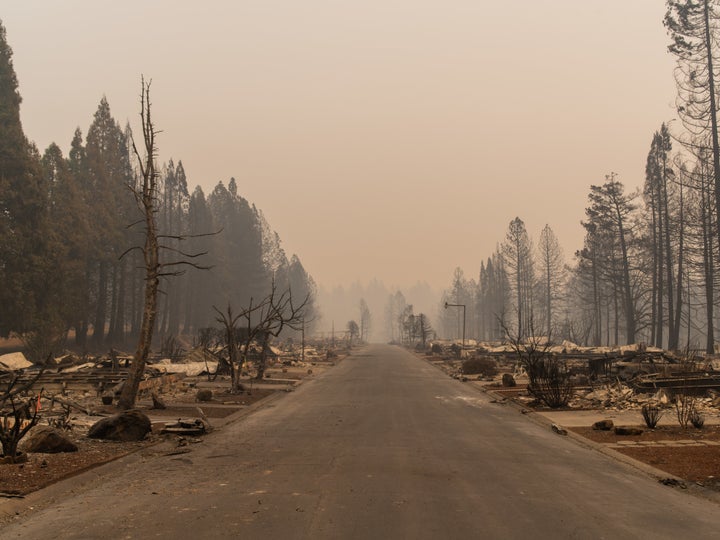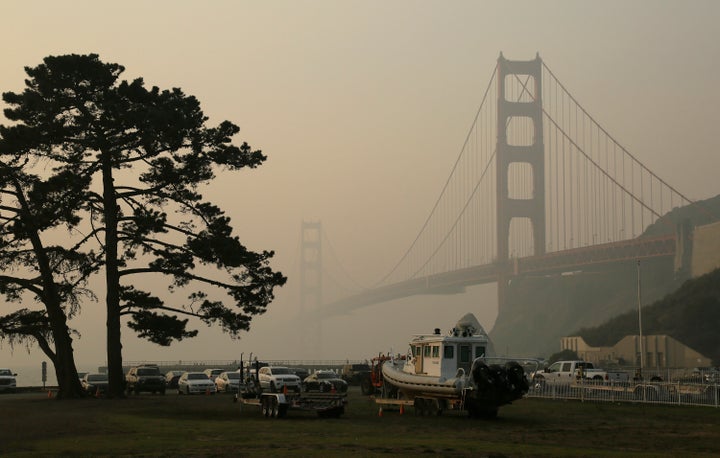SAN FRANCISCO ― Skies so hazy that the Golden Gate Bridge looks like a shadow of itself. A fire so devastating that hundreds of people remain unaccounted for. Air so polluted that people without safety masks are trapped inside. A quarantine set up by the National Guard to limit the spread of a dangerous virus.
This is not the climactic scene of an apocalyptic horror movie, set far in the future. This is California in 2018.
The flames and smoke from the Camp fire ripping through Northern California ― a record-breaking catastrophe that has claimed at least 63 lives with more than 600 people still missing ― is the public health crisis that climate change researchers have been warning about.

In Butte County, where the fire has been raging for more than a week, thousands of people have been evacuated to shelters set up in churches, high schools, fairgrounds and other sites. Many have lost their homes, loved ones and neighbors. The fire has destroyed nearly 10,000 residences so far, and over 15,000 more are threatened, according to the California Department of Forestry and Fire Protection (Cal Fire).
Right now, though, there’s another acute issue preoccupying evacuees and shelter workers.
More than 140 Camp fire evacuees huddled in crowded shelters are showing norovirus symptoms, the Butte County Public Health Department announced Thursday. That number is likely much higher now.
“The number of sick people is increasing every day,” a release from the health department stated. “Twenty-five people have been to the hospital for medical support. Staff serving the shelters have also been sick.”
A visit to the East Avenue Church shelter in Chico shows just how quickly norovirus, the leading cause of foodborne illness, is spreading in a community that has already suffered through so much unforeseen devastation.
Two hundred and fifty people were camped at the church on Friday when illness erupted in one corner of the shelter’s multipurpose room. Evacuees overcome with sudden vomiting, diarrhea and dehydration were eventually protected by a barrier as volunteers rushed to treat them. They were feet away from their fellow evacuees, wearing air filtration masks and precautionary adult diapers, hoping not to add illness to the others’ long lists of misfortunes. While volunteers bleached floors covered in feces and vomit, some evacuees took to the bushes outside the shelter to relieve themselves. These are the indignities of a catastrophe that no one plans for.

It’s not 100 percent certain that all patients are suffering from norovirus specifically, but the threat the infection poses justifies a prompt response. The U.S. Centers for Disease Control and Prevention says that there are about 56,000 to 71,000 hospitalizations and 570 to 800 deaths, mostly young children and the elderly, each year among those infected by it in the U.S.
Later on Friday, the National Guard began setting up medical tents for Camp fire evacuees affected by norovirus in an attempt to better control its spread from shelter to shelter, all overcrowded with people made homeless by the fire and people who were already homeless but needed relief from the smoke. Some brought dogs and other pets.
Meanwhile, counties more than a hundred miles from the fire are grappling with the health consequences of smoke that’s settled around their homes.
Since the Camp fire erupted on Nov. 8, the skies throughout the affected areas and spilling down into the San Francisco Bay Area have been brown and hazy. Visibility is poor. In San Francisco, the tops of buildings seem to disappear into the haze. Everywhere the air smells like fire.
That smoky, polluted air is full of microscopic pieces of particulate matter measuring roughly 2.5 micrometers or smaller, or PM 2.5. These particulates are too small to be caught by our lungs’ filtration system and instead enter our bloodstreams, posing potential health risks to anyone breathing it but particularly to those with respiratory issues, as well as to older adults and children. Coughing, wheezing and other side effects have already affected many of those exposed to the abysmal air.
The Butte County Air Quality Management District reported “hazardous” air quality in Paradise, where the fire started, and in nearby Chico, Oroville and Gridley. The Environmental Protection Agency’s AirNow site reported an Air Quality Index of 350 in Chico. For context, Delhi, India ― one of the most notoriously polluted cities in the world ― on Friday measured an AQI of about 240.
Even the Bay Area, more than 165 miles from the epicenter of the Camp fire, is experiencing air quality conditions considered unsafe for anyone to go outside. The EPA measured an AQI of 238 in San Francisco on Friday.
Northern Californians take their good air for granted. Last year, San Francisco had 276 days with an AQI rating of “good.” The average AQI in Delhi is “poor.”

Many schools and universities throughout the Bay Area have closed in recent days due to the poor air quality. Public schools in San Francisco, Alameda, Contra Costa, Solano and Marin counties canceled classes on Friday due to the poor air quality. The University of California, Berkeley, San Francisco State University, California State University East Bay and other colleges closed their campuses, as well. The Bay Area Air Quality Management District issued a “Spare the Air” alert effective from Thursday through Tuesday that includes a ban on “burning wood, including manufactured fire logs or any other solid fuel, indoors or outdoors.”
Even San Francisco’s famous cable cars were shut down on Friday.
Authorities also urged residents to stay indoors and to wear a mask approved by the National Institute for Occupational Safety and Health, marked N95 or higher, if and when they need to go outdoors.
One ACE hardware store in San Francisco’s Inner Richmond district was out of masks Tuesday night but told customers a shipment of 1,000 more would be in the next morning. By Wednesday night, they were out again.
The shortage is standard across the city. Many vendors have limited customers to four masks per person. That limit has gone down to two in some places as supplies have dwindled.
Smoke entering through the state’s Central Valley is hovering in Bay Area counties, unable to escape through the Golden Gate, the National Weather Service explained. Furthermore, the juxtaposition of high daytime temperatures and low evening ones has triggered a phenomenon that traps the smoke close to the ground.

The particulates in wildfire smoke also have a somewhat different chemical makeup than the particles produced by cars and other daily sources of pollution. And it comes in short, intense episodes during and after a fire, which may present a different set of risks.
Next to the immediate loss of life from the Camp fire, the air quality may seem a distant secondary concern. But how the poor air may affect survivors and other surrounding residents in the long term poses a frightening prospect.
Inhalation of PM 2.5 particles has been linked to premature death in people with heart or lung disease, heart attacks, asthma and other respiratory issues. PM exposure has also been linked to increased kidney disease risk and shortened life spans of those exposed to it in the womb.
Hazy conditions in the Bay Area are projected to persist over the weekend, according to the National Weather Service. As for now, people’s hope for relief from the smoke hinges on a chance of rain that may help clean the air late next week.
Jenavieve Hatch contributed reporting from Chico, California.
